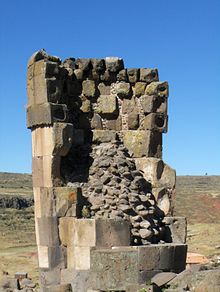
A chullpa is an ancient Aymara funerary tower originally constructed for a noble person or noble family. Chullpas are found across the Altiplano in Peru and Bolivia. The tallest are about 12 metres (39 ft) high.
The tombs at Sillustani are most famous. Recent research has focused on the connection between chullpas and the ritual pathways etched into the landscape around Nevado Sajama, as well as possible patterns within chullpa sites.[1]
Description[edit]
Corpses in each tomb were typically placed in a fetal position along with some of their belongings, including clothing and common equipment.
In virtually all cases, the only opening to the tomb faces the rising sun in the east. The construction of the chullpa varied with ethnic group: in general, those of the north Altiplano are circular and constructed with stone, while those of the south are rectangular and constructed with adobe.[2]
Some are unadorned, while others have intricate carvings. At Sillustani, many of the chullpas have lizards, which were considered a symbol of life because they could regenerate their tails, carved into the stone. [3]
Similar tombs[edit]
It is possible that chullpas were also used by the Inca following their conquest of the Aymara.
Very similar stone constructions on Easter Island known as tupa have sometimes been suspected to be closely related to chullpas.[4]
See also[edit]
- Inka Murata
- Jach'a Phasa
- Kuntur Amaya
- Kunturmarka
- Kutimpu
- Markahirka
- Ninamarka
- Qulu Qulu
- Uskallaqta
- Wanqaran
- Wich'un
References[edit]
- ^ "Chullpas". Archived from the original on 4 February 2012. Retrieved 20 March 2006.
- ^ Martiarena, Laurie M. (2016). The social life of death : mortuary practices in the north-central Andes, 11th–18th centuries. University of East Anglia. OCLC 1101256391.
- ^ "Chullpa" (in Spanish). Archived from the original on 2 September 2006. Retrieved 20 March 2006.
- ^ Heyderdahl, Thor. Easter Island – The Mystery Solved. Random House New York 1989. [ISBN missing]